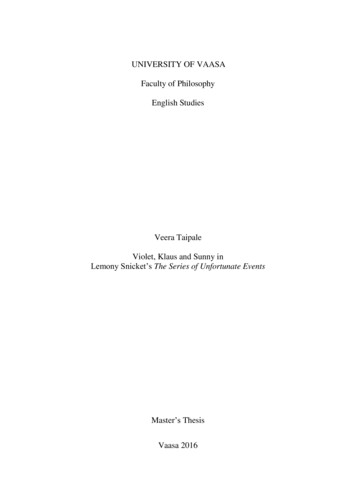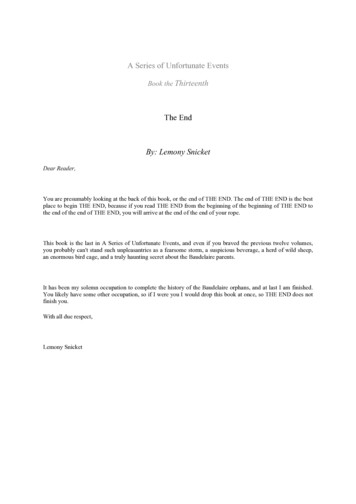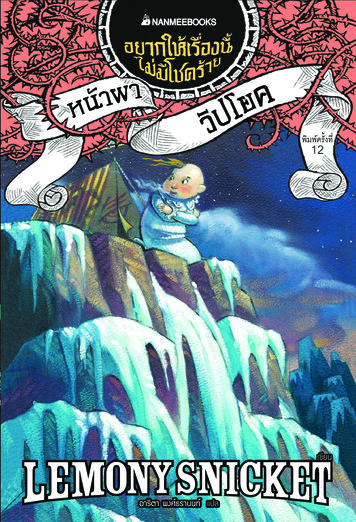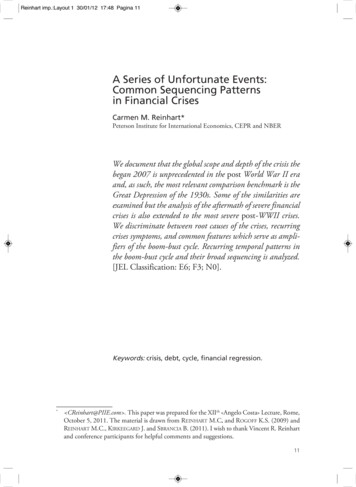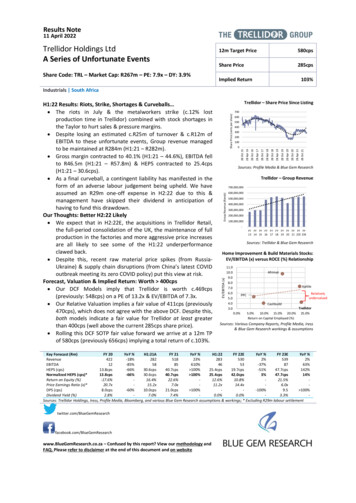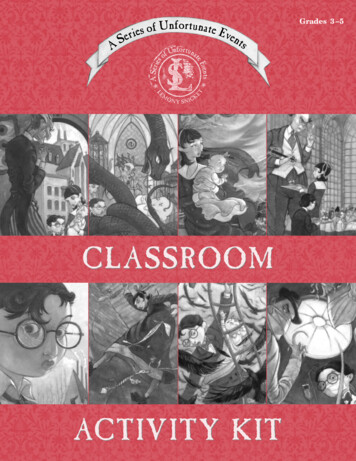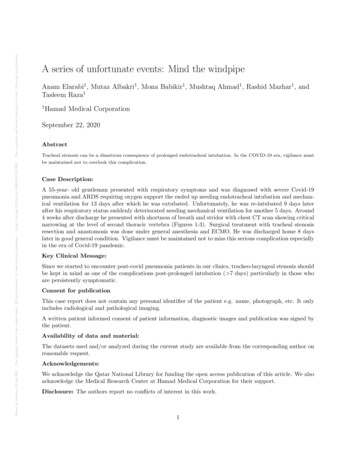
Transcription
Posted on Authorea 22 Sep 2020 — The copyright holder is the author/funder. All rights reserved. No reuse without permission. — https://doi.org/10.22541/au.160081235.53512982 — This a preprint and has not been peer reviewed. Data may be preliminary.A series of unfortunate events: Mind the windpipeAnam Elarabi1 , Mutaz Albakri1 , Mona Babikir1 , Mushtaq Ahmad1 , Rashid Mazhar1 , andTasleem Raza11Hamad Medical CorporationSeptember 22, 2020AbstractTracheal stenosis can be a disastrous consequence of prolonged endotracheal intubation. In the COVID-19 era, vigilance mustbe maintained not to overlook this complication.Case Description:A 55-year- old gentleman presented with respiratory symptoms and was diagnosed with severe Covid-19pneumonia and ARDS requiring oxygen support the ended up needing endotracheal intubation and mechanical ventilation for 13 days after which he was extubated. Unfortunately, he was re-intubated 9 days laterafter his respiratory status suddenly deteriorated needing mechanical ventilation for another 5 days. Around4 weeks after discharge he presented with shortness of breath and stridor with chest CT scan showing criticalnarrowing at the level of second thoracic vertebra (Figures 1-3). Surgical treatment with tracheal stenosisresection and anastomosis was done under general anesthesia and ECMO. He was discharged home 8 dayslater in good general condition. Vigilance must be maintained not to miss this serious complication especiallyin the era of Covid-19 pandemic.Key Clinical Message:Since we started to encounter post-covid pneumonia patients in our clinics, tracheo-laryngeal stenosis shouldbe kept in mind as one of the complications post-prolonged intubation ( 7 days) particularly in those whoare persistently symptomatic.Consent for publicationThis case report does not contain any personal identifier of the patient e.g. name, photograph, etc. It onlyincludes radiological and pathological imaging.A written patient informed consent of patient information, diagnostic images and publication was signed bythe patient.Availability of data and material:The datasets used and/or analyzed during the current study are available from the corresponding author onreasonable request.Acknowledgements:We acknowledge the Qatar National Library for funding the open access publication of this article. We alsoacknowledge the Medical Research Center at Hamad Medical Corporation for their support.Disclosure: The authors report no conflicts of interest in this work.1
Posted on Authorea 22 Sep 2020 — The copyright holder is the author/funder. All rights reserved. No reuse without permission. — https://doi.org/10.22541/au.160081235.53512982 — This a preprint and has not been peer reviewed. Data may be preliminary.Authors contributions:Dr. Anam M. Elarabi, Corresponding author, manuscript review and submissionDr. Mutaz M. Albakri. Co-author, manuscript writing, review and finalization.Dr. Mona Babikir, Manuscript review.Dr. Mushtaq Ahmed, Manuscript review.Dr. Rashid Mazhar, Manuscript review.Dr. Tasleem Raza, Manuscript review.Figure 1: 3D reconstruction of CT-Chest showing the level and extent of the tracheal stenosis (Anteriorview)Figure 2: 3D reconstruction of CT-Chest showing the level and extent of the tracheal stenosis (Posteriorview)2
Posted on Authorea 22 Sep 2020 — The copyright holder is the author/funder. All rights reserved. No reuse without permission. — https://doi.org/10.22541/au.160081235.53512982 — This a preprint and has not been peer reviewed. Data may be preliminary.Figure 3: Saggital section of the CT-scan Chest showing the significant narrowing of the tracheal at thesecond thoracic vertebral level.3
Posted on Authorea 22 Sep 2020 — The copyright holder is the author/funder. All rights reserved. No reuse without permission. — https://doi.org/10.22541/au.160081235.53512982 — This a preprint and has not been peer reviewed. Data may be preliminary.4
Posted on Authorea 22 Sep 2020 — The copyright holder is the author/funder. All rights reserved. No reuse without permission. — https://doi.org/10.22541/au.160081235.53512982 — This a preprint and has not been peer reviewed. Data may be preliminary.5
Posted on Authorea 22 Sep 2020 — The copyright holder is the author/funder. All rights reserved. No reuse without permission. — https://doi.org/10.22541/au.160081235.53512982 — This a preprint and has not been peer reviewed. Data may be preliminary.6
Posted on Authorea 22 Sep 2020 — The copyright holder is the author/funder. All rights reserved. No reuse without permission. — https://doi.org/10.22541/au.160081235.53512982 — This a preprint and has not been peer reviewed. Data may be preliminary.7
A series of unfortunate events: Mind the windpipe Anam Elarabi 1, Mutaz Albakri , Mona Babikir 1, Mushtaq Ahmad , Rashid Mazhar1, and Tasleem Raza1 1Hamad Medical Corporation September 22, 2020 Abstract Tracheal stenosis can be a disastrous consequence of prolonged endotracheal intubation. In the COVID-19 era, vigilance must

